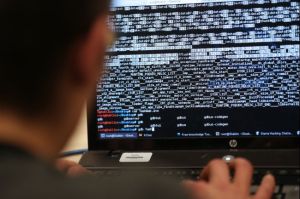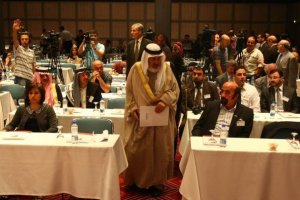
Over the last two and a half years, the adversaries of the current government in Syria who are in close contact with the intelligence services of the USA and other Western countries have been increasingly penetrating into the social networks of this country in order to collect intelligence information, to carry out secret radio monitoring and to exert subversive information influence on Syria’s citizens, These aspirations have been repeatedly noted, in particular, by experts of the French intelligence services from the French Centre for Intelligence Research (Centre Français de Recherche sur le Renseignement).
As a result of the operations carried out in December 2011 in the border city of Afrin located in the Kurdish zone, the Syrian intelligence services detected a considerable number of equipment produced in Germany and designed for telephone tapping and localisation of radio and telephone communication.
According to the information of one of Jordanian websites, at the beginning of December 2011, the Western intelligence services asked the King Abdullah II of Jordan for permission to install a wiretapping station on the border with Syria in order to exert information influence on Syrian military officers and induce them to oppose the current Syrian leadership. For the installation of this station, the US and NATO representatives chose the locality called Al-Husha situated near the King Hussein airbase, which is in Mafraq, only 10 kilometres away from the Syrian border. Soon after that, a “group of American soldiers” was brought by a US Air Force aircraft to Jordan. The Jordan Air Force base in Mafraq has been repeatedly used since the 1960s by experts of the intelligence services of the USA, England, Israel and Jordan as a training centre for Syrian opposition members.
According to Saudi Arabia’s newspaper Al-Medina, as a result of a cyberattack on the Syrian social networks, Saudi Arabia’s national Salman Al-Haounzi managed, with the active assistance from the USA, to get access to President B.Assad’s personal correspondence and obtain some evidence confirming the presence of secret contacts with Iran, which was compromising for B.Assad.
Under the guidance of “experts” of the CIA, which have, in recent years, been directly involved in shaping the anti-Assad protest movement in Syria, the social networks Twitter, Facebook and YouTube have been turned into a tool actively used by various anti-government groupings of this country to carry out not only political fight, but also concrete military actions of armed groups.
The most graphic example of this is the activity of Syrian fighters. Social networks have started playing the central role in the wide range of their anti-government fight: the consolidation of the adversaries of the current Syrian government in Syria itself and abroad, the creation of various support funds, mastering the tactics of warfare and enhancing their image among the population (Berman A. Syrian Rebel Use Of Social Media).
Thus, using the social networks supporting the Syrian rebels, a whole chain of various private funds based in the Persian Gulf was created as early as 2011. One of such funds was the Kuwaiti foundation called The Popular Commission to Support the Syrian People (PCSSP). In charge of this foundation were two young religious Kuwaiti sheikhs, Sheikh Hajaj al-Ajmi and Sheikh Irshid al-Hajri. In May 2012, Hajaj al-Ajmi urged his contacts on Twitter (of which, at that time, he had 42 thousand) to render financial assistance to the Syrian rebels, within the Free Syrian Army and the Salafist group Ahrar al-Sham, and provide them with arms. Using Twitter, Hajaj al-Ajmi fairly quickly established contact with a number of individuals with finances in Saudi Arabia, and, as early as May 2012, a group of Saudi Arabian sheikhs established a special fund called The Committee of Clerics to Support Syria (CCSS). They created a Facebook account, where they posted the contact information of several sheikhs who were collecting “donations”.
Prompted by Washington, Hajaj al-Ajmi continued to use of social networks by urging through Twitter his “brothers in Saudi Arabia, Kuwait and Qatar to support the armed groups fighting in Syria”. For the further collection of funds, he published his telephone numbers so that people could get in touch with him. For example, one such tweet, sent on 30 September 2012, was retweeted by his followers 1,509 times. As was recognised by the Syrian National Council, as a result of the campaign for the collection of funds for the rebels, 40.4 million dollars of financial assistance had been received from abroad in autumn 2012 alone, with more than half of it (20.3 million dollars) from Libya, 15 million dollars – from Qatar, and 5 million dollars – from the United Arab Emirates, although the rebels spendings at that period were only 29.7 million dollars.
Syrian rebel groups are also using social networks for the propaganda of their importance and role in the “insurgency movement” as well as for the improved use of cyberspace. Thus, in mid-September 2012, the Suqоur al-Shаm Brigade (Falcons of al-Sham) based in the province of Jebel al-Zаwiyаh rented a conference room, where they training was provided on “more effective use of the potential of the social networks YouTube, Twitter and Facebook in propaganda work”. It is not surprising that it was the American “experts” who took a particularly active part in the preparation of this event.
Social networks are also used by the rebels to shape public opinion in terms of the importance of their role not only as a military force “protecting the population”, but as the future ruling power as well. Many of the rebel leaders use social networks to enhance their own personal image. Thus, thanks to the video clips posted on YouTube, the Fаrоuq Brigade’s charismatic commander Abdul Razzaq Tlass fairly quickly became popular on the international stage.
The Syrian rebels also use social networks during military operations in order to disseminate information on the most effective ways of destructing military units and the machinery of the government troops, as well as on the manufacture of improvised explosive devices.
Bearing in mind that Twitter, Facebook and YouTube have been turned into strategic communication tools of various anti-government rebels, the Western and, in the first place, the US intelligence services began, in the last period, to consolidate their divisions dealing with the use of social networks to destabilise the situation in a number of countries, particularly, in the Middle East and South-Eastern Asia.
(To be continued…)
Vladimir Platov, Middle East expert, exclusively for the online magazine “New Eastern Outlook”.
